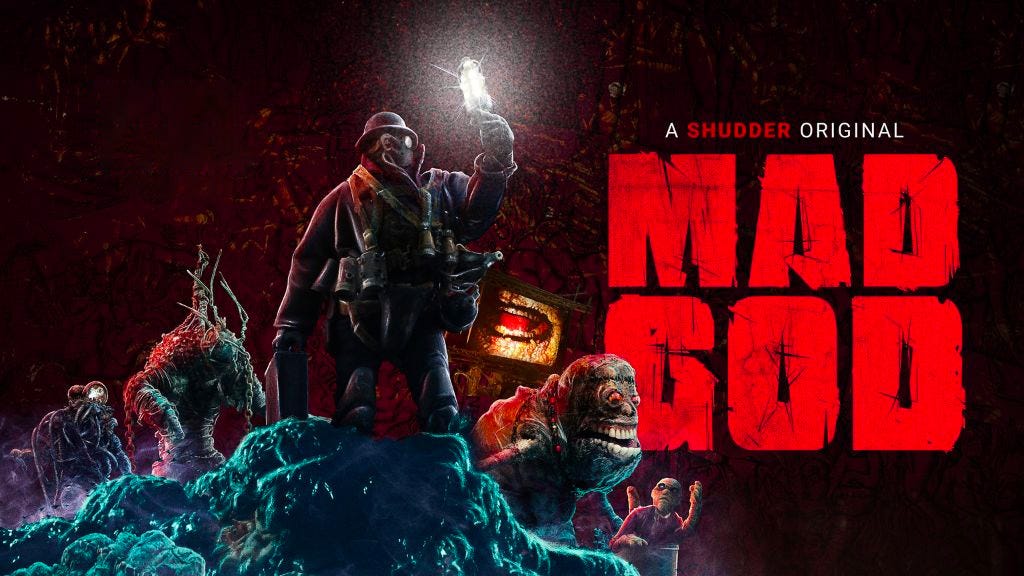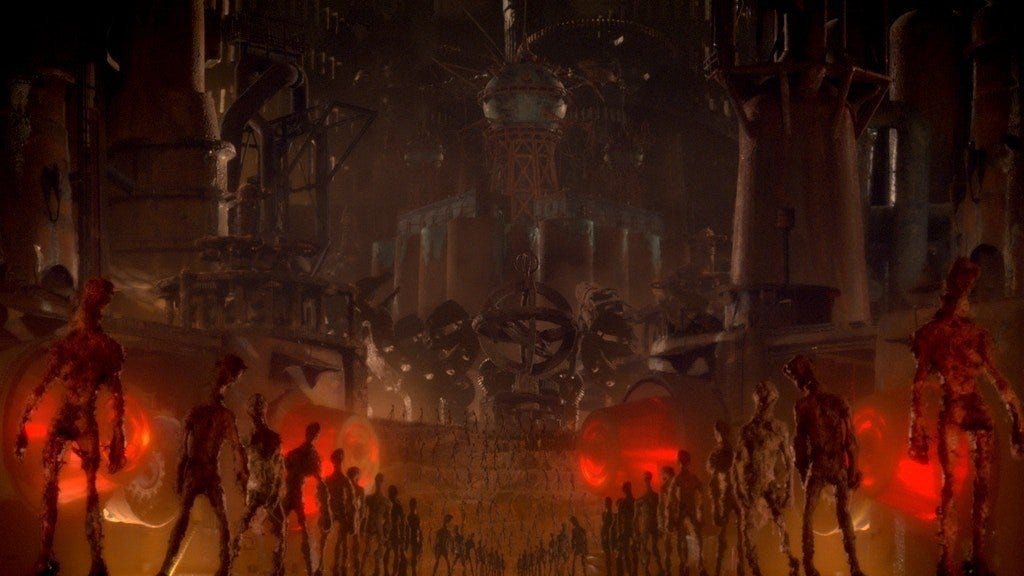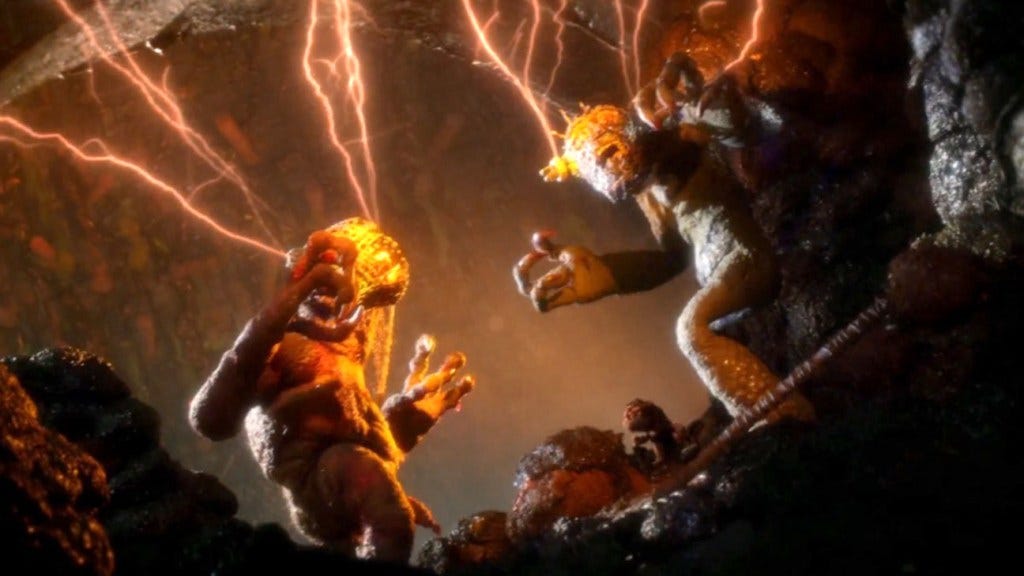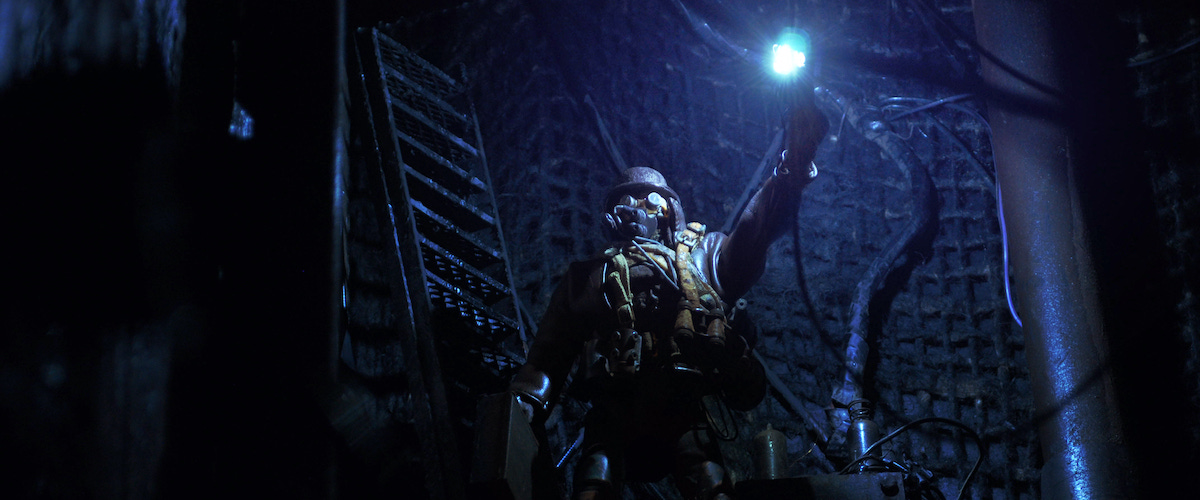It’s been a while since I posted any real reviews, and I wasn’t really in the mood to write one today. That changed, though, when I watched “Mad God”. In fact, it was only a couple of minutes into the film that I just started writing notes with an excited grin, hungry to write down my thoughts and eager to share. The kind of film that makes me wish I didn’t have to blink, so that I can absorb every second of its glory. With that in mind, please forgive me if this review is sloppy, I’m a bit rusty.
I’ll open by saying that this film is not for the weak stomached. If you prefer your Hollywoods to your niche arthouse films and Hammer Horror’s, then this film is not for you. If this statement excites you, however, then read on, because you’re about to have your socks blown clean off.
Lets start with the setting(s), which can only be described by using fancy words like “phantasmagorical”, “nightmarescape”, and “grotesque”. Well, now that I’ve got that out of my system, I can get on with it. The settings that Phil Tippett’s masterpiece utilises are extremely unique due to the absurdity of Phil’s artistic direction. His worlds are playful in scale, almost always horrifying to look at, but most importantly they are all exceptionally intriguing. Every shot of every scene is a kind of dystopian painting by Hieronymus Bosch, or Zdzisław Beksiński. In fact, I wrote in my notes “It is as though Clive Barker was told to write a story set in a Beksiński painting.” and that initial thought seems to have carried over right through the film.
The thing with stop motion is that the sets are built by hand, and the quirky characteristics of such are deliberately displayed, warts and all. I appreciated every handpainted toilet roll tube*, every pile of gunge, every melted toy soldier. Tippett was a fan of mistakes, and what better playground for mistakes to happen than on a set full of crazy monsters and hodgepodge architecture? I’ve not really seen anything quite like this. It feels a bit like Karel Zeman after a mental breakdown.
My favourite aspect of the settings are the dramatic scale variations at play. Phil contrasts monolithic structures with miniscule people† and vice versa. Tortured giants sit atop massive toilets while our protagonist strolls by at one-hundredth the size. The same protagonist who steps on, and squishes, two little people† without noticing. Graveyards of concrete towers eclipse the sky, as do mountains of dead soldiers. It complements the dreamlike quality of the thing, the randomness of everything going on. In addition, these playful settings are befitting of the technique used to make this film. Stop motion is a test of utilising random objects, taking some mundane everyday thing and making it look like a creature, or a tower. In a way this makes the strangeness of the size of things a homage to the industry.
*I have no idea if Tippett used bog roll tubes, but it’s a solid guess
†They’re not really people, more like humanoid nightmare fuel
The Score! There is no dialogue in Mad God, so the score is extra important. I’m happy to report that the music, composed by Dan Wool, and all of foley sound effects are excellent. The music assists heavily in creating the dreamlike tone of the film, and at times, creates a mood of hope when the visuals seem to indicate otherwise. These evolving tones conjured by the score transcend the film beyond the “horror” label and into something more beautiful. The feelings evoked in me by Dan Wool’s score are some of the most intense I’ve felt from watching a film in a long time.
Speaking of tone: fatalism comes to mind. The inevitability of our self-destruction and the cruelty that exists in the world. I know, I just said there were hopeful parts in the score, but the complexity of these different emotions are what makes this film so great, so bare with me. This film is telling you that you are both The Universe, and you are nothing.
Phil Tippett said he was “motivated by the unconscious and not by intention” yet, I can’t help but think there is some message being conveyed. Is it one of war? The absurdity of life? Perseverance? Capitalism? Just an artist messing about? Maybe the artist IS the Mad God? I don’t know, but I do know what message I got from it, and that is one of fatalism. Many of the “people” in Mad God are in pain or dying, or otherwise in a state of perpetual pointlessness. It feels to me as though Tippett is a glass half empty kind of guy. I love this theme even if it happened by unconscious design choices. It is the same theme I like to read in novels.
There is a scene where two imprisoned monkeylike creatures are fighting among themselves while being forced to shovel shit with their dicks swinging freely. There is another scene where a crowd of faceless humanshaped creatures are watching a rotating television type of structure emitting a baby babbling noise which reminded me of watching daytime television, in particular the news. These two scenes paint the perfect picture of the message I got from this film, but maybe that’s just my own cynicism coming out. We are, after all, slaves to an indifferent societal system…
Artistic Direction: everything is covered in cobwebs, shit, blood, belly button fluff and slime. There are saggy titties, gaping assholes and puking monsters. Everything you’d want from a film, right?
I loved the art direction of Mad God. From the wacky camera angles to the atmospheric lighting, the grotesque style, everything had Tippett’s passion injected into it. You might read that list of horrible stuff and think this is shock-horror, and it is, but it’s done in a way that never feels pushed too far. Everything has a place and everything is artfully utilised and assists in making it feel more like a dream than a film. The colour direction of the film is especially dramatic, from cool blue darkness to foggy neutral hues to saturated warm tones, every scene takes colour into consideration. This might be a dark fantasy horror, but that doesn’t mean it doesn’t use every colour under the rainbow! There’s even a trippy overly saturated scene, which I loved.
Mad God is made from the same chaos that exists in dreams.
The Plot! Okay, I’ve left this till last because it is the part I’m least sure of. Just when you think you get it, something even more unexpected and strange happens.
Is there a plot? Well I would consider the repetitiveness of our self-torture the plot. Technically, I think it’s about an assassin trying to blow something up, then failing… only to be reborn to try again? I can’t quite remember.
We follow an unnamed assassin as he journeys towards an unknown destination, observing things dying needlessly, usually by some grim unfortunate event like war or they end up as food, or just for no reason whatsoever. The death is so abundant and blasé, in fact, that it borders on hilarious. That’s all I can tell you about the plot, I’m afraid.
I’ll conclude by saying that this may be one of the best films I’ve ever watched. I may re-watch it again this week.
Thank you for taking the time to read this review








I love stop motion generally, and this sounds like a treat. It's great when you watch a film and feel the need to make notes then put it out there. Thanks for sharing. I shall be watching.
Love your review even though it sounds like a film i wont enjoy ❤️